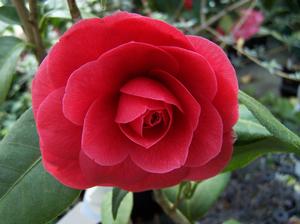
Camellia is gloriously non-toxic
Non-toxic Houseplant Alternatives
Many non-toxic houseplants are available. The following roster includes safe or at least safer alternatives to the list of potentially toxic plants I shared with you in November.
Even if plants are considered non-toxic additional safety measures can be implemented. It would be wise practice to raise plants out of reach of young children who have not yet developed reasoning skills and, of course, pets who in avid innocence might dine on a plant that could upset a tummy or worse. Unless a plant is genuinely edible to quadrant it off for safety can only augment peace of mind. This can be accomplished with bracketed shelves placed at the upper portion of a window which set the plants on a higher plane out of easy reach. Boxed, oriels and bay windows that jut from the side of a home can be completely closed off to testing toddlers or marauding pets. And then there are the mini ecosystems of terrariums that are life bubbles closed-off from the outer world. Hanging plants can always be raised higher placing them completely out of reach of grasping hands. But maintain careful watch upon any hanging plant and, indeed, any plant on an upper shelf, that will grow and dangle. Before a precarious moment arrives employ the scissors or pruners and dispose of unwanted cuttings in a safe and appropriate manner.
All the following plants are listed with the common name followed by the designating botanical Latin name which best hones and identifies the plant. Always apply caution and be certain that the non-toxic plant you desire is the one that you have acquired. In as much as possible do the homework and match a common name with the botanical Latin moniker for better assurance that you have properly identified a genuinely safe or safer plant. Remember: some common plant names are interchangeable and might possibly lead you to a plant that may contain compounds that may be deleterious.
All the following plants are considered safe. A plant with an asterisk (*) denotes a plant whose sap may be irritating only to the relative few who may harbor genetic sensitivity.
Aluminum Plant - Pilea species; African Violets - Saintpaulia ionantha; Areca Palm - Chrysalidocarpus lutescens; Baby’s tears - Soleiria soleirolii; Bird of Paradise - Strelitzia reginae; Bird’s Nest Fern - Asplenium nidus; Boston Fern - Nephrolepis exaltata; Camellia - Camellia sinensis, Camellia japonica; Cast Iron Plant - Aspidistra elatior; Christmas cactus - Schlumbergera bridgesii; Coleus - Coleus hybridus; Donkey’s Tail - Sedum morganianum; Earth Star - Cryptanthus bivittatus; EcheveriaEcheveria spp.; Figs, Weeping and Fiddleleaf - *Ficus spp.; Geraniums (not to be confused with actual hardy geraniums, Cranesbill) - Pelargonium spp.; Golden Bamboo - Phyllostachys aurea; Goldfish Plant - Columnea spp.; Impatiens - Impatiens wallerana; Japanese Aralia - Fatsia japonica; Lipstick Plant - Aeschynanthus spp.; Maidenhair Fern - Adiantum spp.; Miniature Roses - Rosa spp.; Nerve Plant - Fittonia spp.; Norfolk Island Pine - Araucaria heterophylla; Orchids Cattleya, Epidendrum, Oncidium, Paphiopedilum spp. ; Palms - most are nontoxic except Fishtail Palm, Caryota ; Peperomia - Peperomia spp.; Piggyback Plant - *Tolmiea mensziesii; Prayer Plant - Maranta leuconeura; Purple Passion Plant - Gynura aurantiaca; Sensitive Plant - Mimosa puddica; Spider Plant - Chlorophytum comosum; Surinam Cherry - Eugenia uniflora; Swedish Ivy - Plectranthus spp.; Wandering Jew - Tradescantia pallida; Wax Plant - Hoya carmosa; Zebra Plant - Aphelandra squarrosa
There are many more plants - tropical, sub-tropical and even temperate zone that can make terrific house plants. And there are many sites which can provide you with pertinent information as to whether or not any among them may be appropriate for your home. The University of California has put together extensive lists of both toxic and non-toxic plants. The criteria can be accessed by either common name or botanical Latin. Google UCAL poison plants or type the following web address into your browser: http://ucanr.edu/sites/poisonous_safe_plants/ Whether your needs are plants which are poisonous or non-toxic to pets or people the left hand menu provides you with specified search possibilities.
Houseplants offer a softening aesthetic, provide a touch of serene, calming life to a room and they very often double as filters removing toxins from the air we breath. Know your light exposure - the direction your window(s) face coupled with a sage understanding of the impact of trees, be there any, which may cast some shade will help to lead to appropriate choices. Nighttime room temperatures, species dependent, can fundamentally impact baseline needs of a plant that has caught your fancy. These measures, too, are easily accessed on line. One may choose to have no greenery but there is nothing like a winter flowering houseplant to provide heart warming hope and joy during the bleakest days of the year. Dig in. Have fun.
penned by Wayne Paquette October, 2015